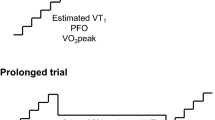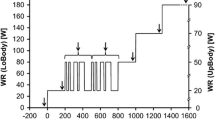Abstract
This study compared ventilation, gas exchange (oxygen uptake, V̇O2) and the surface electromyogram (EMG) activity of four major lower limb muscles during heavy exercise before (Pre-Ex) and after (Post-Ex) a sustained 90-min cycling exercise at 60% V̇O2peak. The 90-min exercise was incorporated under the hypothesis that sustained exercise would alter substrate availability in the second exercise bout causing differences in fibre recruitment patterns, gas exchange and ventilation. Nine trained male subjects [V̇O2peak=60.2 (1.7) ml·kg−1·min−1] completed two identical 6-min bouts of cycling performed at high intensity [~90% V̇O2peak; 307 (6) W, mean (SE)]. Ventilation and gas exchange were measured breath-by-breath and the EMG was recorded during the last 12 s of each minute of the two 6-min bouts. EMG signals were analysed to determine integrated EMG (iEMG) and mean power frequency (MPF). V̇O2 at min 3 and min 6 in Post-Ex were significantly higher (i.e., +201 and 141 ml·min−1, respectively, P<0.05) than in Pre-Ex but there was a ~25% decrease of the slow component, taken as the difference between min 6 and min 3 [187 (27) vs 249 (35) ml·min−1, respectively, P<0.05]. The greater whole-body V̇O2 after 3 min of exercise in Post-Ex was not accompanied by clear alterations in the iEMG and MPF of the examined leg muscles. Ventilation and heart rate were elevated (~12–16 l·min−1 and ~10 beats·min−1, respectively, P<0.05) as were the ratios V̇ E/O2 and V̇ E/V̇CO2 in the Post-Ex tests. It was concluded that the V̇O2 and ventilation responses to high-intensity exercise can be altered following prolonged moderate intensity exercise in terms of increased amplitude without associated major changes in either iEMG or MPF values among conditions.



Similar content being viewed by others
References
Barstow TJ, Jones AM, Nguyen PH, Casaburi R (1996) Influence of muscle fiber type and pedal frequency on oxygen uptake kinetics of heavy exercise. J Appl Physiol 81:1642–1650
Bigland-Ritchie B, Donovan B, Roussos CS (1981) Conduction velocity and EMG power spectrum changes in fatigue of sustained maximal efforts. J Appl Physiol 51:1300–1305
Bohnert B, Ward SA, Whipp BJ (1998) Effects of prior arm exercise on pulmonary gas exchange kinetics during high-intensity leg exercise in humans. Exp Physiol 83:557–570
Borrani F, Candau R, Millet GY, Perrey S, Fuchslocher J, Rouillon JD (2001) Is the VO2 slow component dependent on progressive recruitment of fast-twitch fibers in trained runners? J Appl Physiol 90:2212–2220
Burnley M, Jones AM, Carter H, Doust JH (2000) Effects of prior heavy exercise on phase II pulmonary oxygen uptake kinetics during heavy exercise. J Appl Physiol 89:1387–1396
Burnley M, Doust JH, Carter H, Jones AM (2001) Effects of prior exercise and recovery duration on oxygen uptake kinetics during heavy exercise in humans. Exp Physiol 86: 417–425
Burnley M, Doust JH, Ball D, Jones AM (2002) Effects of prior heavy exercise on VO2 kinetics during heavy exercise are related to changes in muscle activity. J Appl Physiol 93:167–174
Coast JR, Rasmussen SA, Krause KM, O'Kroy JA, Loy RA, Rhodes J (1993) Ventilatory work and oxygen consumption during exercise and hyperventilation. J Appl Physiol 74:793–798
Gerbino A, Ward SA, Whipp BJ (1996) Effects of prior exercise on pulmonary gas-exchange kinetics during high-intensity exercise in humans. J Appl Physiol 80:99–107
Gollnick PD, Piehl K, Saltin B (1974) Selective glycogen depletion patterns in human muscle fibres after exercise of varying intensity and at varying pedalling rates. J Physiol (Lond) 241:45–57
González-Alonso J, Calbet JA, Nielsen B (1998) Muscle blood flow is reduced with dehydration during prolonged exercise in humans. J Physiol (Lond) 513:895–905
Gonzalez-Alonso J, Calbet JA, Nielsen B (1999) Metabolic and thermodynamic responses to dehydration-induced reductions in muscle blood flow in exercising humans. J Physiol (Lond) 520 Pt 2:577–589
Green H, Houston M, Thomson J, Reid P (1979) Alterations in ventilation and gas exchange during exercise- induced carbohydrate depletion. Can J Physiol Pharmacol 57:615–618
Heigenhauser GJF, Sutton JR, Jones NL (1983) Effect of glycogen depletion on the ventilatory response to exercise. J Appl Physiol 54:470–474
Helal JN, Guezennec CY, Goubel F (1987) The aerobic-anaerobic transition: re-examination of the threshold concept including an electromyographic approach. Eur J Appl Physiol 56:643–649
Hughson RL, Kowalchuk JM (1981) Influence of diet on CO 2 production and ventilation in constant-load exercise. Respir Physiol 46:149–160
James DV, Doust JH (1999) Oxygen uptake during high-intensity running: response following a single bout of interval training. Eur J Appl Physiol 79:237–243
Jensen BR, Pilegaard M, Sjogaard G (2000) Motor unit recruitment and rate coding in response to fatiguing shoulder abductions and subsequent recovery. Eur J Appl Physiol 83:190–199
Koga S, Shiojiri T, Kondo N, Barstow TJ (1997) Effect of increased muscle temperature on oxygen uptake kinetics during exercise. J Appl Physiol 83:1333–1338
Koppo K, Bouckaert J (2000) In humans the oxygen uptake slow component is reduced by prior exercise of high as well as low intensity. Eur J Appl Physiol 83:559–565
Lucia A, Hoyos J, Chicharro JL (2000) The slow component of VO2 in professional cyclists. Br J Sports Med 34:367–372
MacDonald M, Pedersen PK, Hughson RL (1997) Acceleration of VO2 kinetics in heavy submaximal exercise by hyperoxia and prior high-intensity exercise. J Appl Physiol 83:1318–1325
Nybo L, Jensen T, Nielsen B, Gonzalez-Alonso J (2001) Effects of marked hyperthermia with and without dehydration on VO2 kinetics during intense exercise. J Appl Physiol 90:1057–1064
Oren A, Whipp BJ, Wasserman K (1982) Effect of acid-base status on the kinetics of the ventilatory response to moderate exercise. J Appl Physiol 52:1013–1017
Paterson DH, Whipp BJ (1991) Asymmetries of oxygen uptake transients at the on- and offset of heavy exercise in humans. J Physiol (Lond) 443:575–586
Perrey S, Betik AC, Candau R, Rouillon JD, Hughson RL (2001) Comparison of oxygen uptake kinetics during concentric and eccentric cycle exercise. J Appl Physiol 91:2135–2142
Petrofsky JS (1979) Frequency and amplitude analysis of EMG during exercise on the bicycle ergometer. Eur J Appl Physiol 41:1-15
Poole DC, Schaffartzik W, Knight DR, Derion T, Kennedy B, Guy HJ, Prediletto R, Wagner PD (1991) Contribution of exercising legs to the slow component of oxygen uptake kinetics in humans. J Appl Physiol 71:1245–1253
Scheuermann BW, Hoetling BD, Noble ML, Barstow TJ (2001) The slow component of O2 uptake is not accompanied by changes in muscle EMG during repeated bouts of heavy exercise in humans. J Physiol (Lond ) 531:245–256
Sejersted OM, Vollestad NK (1992) Increased metabolic rate associated with muscle fatigue. Med Sport Sci 34:115–130
Shinohara M, Moritani T (1992) Increase in neuromuscular activity and oxygen uptake during heavy exercise. Ann Physiol Anthrop 11:257–262
Spengler CM, Knopfli-Lenzin C, Birchler K, Trapletti A, Boutellier U (2000) Breathing pattern and exercise endurance time after exhausting cycling or breathing. Eur J Appl Physiol 81:368–374
Stulen FB, DeLuca CJ (1981) Frequency parameters of the myoelectric signal as a measure of muscle conduction velocity. IEEE Trans Biomed Eng 28:515–523
Thomson JA, Houston ME, Green HJ (1978) Muscle glycogen depletion patterns in fast twitch fiber subgroups of man during submaximal and supramaximal exercise. Pflugers Arch 379: 105–108
Watt MJ, Heigenhauser GJ, Dyck DJ, Spriet LL (2002) Intramuscular triacylglycerol, glycogen and acetyl group metabolism during 4 h of moderate exercise in man. J Physiol (Lond) 541: 969–978
Winter DA, Yack HJ (1987) EMG profiles during normal walking: stride-to-stride and inter-subject variability. Electroencephalogr Clin Neurophysiol 67:402–411
Acknowledgements
Special thanks are given to the subjects for their participation and to Jason Myers for his assistance in this experiment. This study was supported by a Natural Sciences and Engineering Research Council of Canada (NSERC) grant. Stephane Perrey was supported by a grant from the Franche Comté regional council in France.
Author information
Authors and Affiliations
Corresponding author
Rights and permissions
About this article
Cite this article
Perrey, S., Candau, R., Rouillon, JD. et al. The effect of prolonged submaximal exercise on gas exchange kinetics and ventilation during heavy exercise in humans. Eur J Appl Physiol 89, 587–594 (2003). https://doi.org/10.1007/s00421-003-0822-6
Accepted:
Published:
Issue Date:
DOI: https://doi.org/10.1007/s00421-003-0822-6




